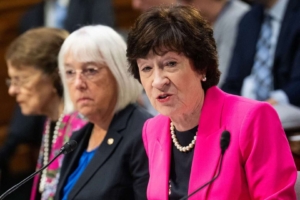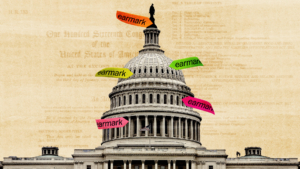
Aid to Israel and Ukraine Stuck in Same Mud as Stopgap Spending Measure
New House Speaker Mike Johnson promised a new form of government, but so far it looks like the same dysfunction with a new wrapper. Congress has a little more than a week to avoid a partial government shutdown and signs aren’t promising.
 Johnson wrangled a $14 billion Israeli aid bill through his fractious caucus by attaching it to an equal-sized cut in the Internal Revenue Service budget. With just 10 days until the current continuing spending resolution expires, Johnson is floating the idea of a “laddered” stopgap spending measures. Senate Democrats quickly blocked the Israel-IRS measure. The laddered-CR concept may not even make it out of the House.
Johnson wrangled a $14 billion Israeli aid bill through his fractious caucus by attaching it to an equal-sized cut in the Internal Revenue Service budget. With just 10 days until the current continuing spending resolution expires, Johnson is floating the idea of a “laddered” stopgap spending measures. Senate Democrats quickly blocked the Israel-IRS measure. The laddered-CR concept may not even make it out of the House.
There is bipartisan Senate support for an aid package that includes both Israel and Ukraine. Senate Republicans are working on a provision to add emergency funding to bolster southern border controls, which President Biden and Senate Democrats have signaled they could support in some form. A majority in the House probably would support it, too – if they get the chance to vote on it.
The short-term continuing resolution that ends November 17 was the last straw for hard-right House conservatives who led the ouster of former Speaker Keven McCarthy. Understandably, Johnson is approaching a second continuing resolution with caution. Some of his MAGA supporters seem to be approaching a shutdown with glee.
The laddered approach, which means passing more than one continuing resolution for different spending categories, is Johnson’s dreamchild for avoiding the political embarrassment of a partial government shutdown just before the Thanksgiving holiday. It’s risky, controversial and time-consuming to construct.
 Unconventional, Not Unprecedented
Unconventional, Not Unprecedented
While unconventional, the idea isn’t unprecedented. In 1991, President George H. Bush’s administration negotiated a split continuing resolution with a Democratic Congress. The first continuing resolution was short to allow for final negotiations on new fiscal year spending levels.
The second continuing resolution provided more time to reach agreement on foreign aid to Israel, which requested a $10 billion loan to address more than 400,000 Jewish emigres from the Soviet Union. Because of unresolved disagreements between Congress and the Bush administration on the request, another continuing resolution was required. The loan issue wasn’t resolved until 1993.
Johnson’s ladder approach has already run into an unmovable object – the calendar. After introducing the idea last week and working on details over the weekend, it has become clear that trying to navigate multiple continuing resolutions through a divided House is unlikely. So, Johnson is back on the hook to pass a continuing resolution to prevent a shutdown less than 10 days from now on November 17.
Pressing Time Crunch
The time crunch isn’t Johnson’s fault. It took three weeks for quarreling House Republicans to choose and vote for a replacement for McCarthy. Without an elected Speaker, the House was unable to act on any legislation, including 12 appropriations waiting for a floor vote.
Voting on appropriation bills has occurred since Johnson took the gavel, with time out for votes on three unsuccessful motions to expel or sanction sitting House members. However, the spending measures advanced by majority House Republicans feature deep cuts that exceed spending limits in the debt limit compromise negotiated by McCarthy and President Biden.
 Senate Appropriations Chair Patty Murray, D-Washington, and Ranking Republican Susan Collins, R-Maine, have teed up appropriations adhering to the spending limits in the debt limit deal, which sets the stage for intense House-Senate conference committees to resolve differences. That isn’t expected to be a breeze or quick. That leaves Johnson with the fiscal and political dilemma to extend the soon-to-expire continuing resolution.
Senate Appropriations Chair Patty Murray, D-Washington, and Ranking Republican Susan Collins, R-Maine, have teed up appropriations adhering to the spending limits in the debt limit deal, which sets the stage for intense House-Senate conference committees to resolve differences. That isn’t expected to be a breeze or quick. That leaves Johnson with the fiscal and political dilemma to extend the soon-to-expire continuing resolution.
Most congressional continuing resolution are eleventh-hour, poker-face affairs. Often there is plausible blame on more than one party. In this case, the culprit will be easy to identify. Chaos in the House Republican caucus chewed up valuable time to find a compromise. Johnson’s ladder idea may not gel in time to avoid an up or down vote on another all-encompassing continuing resolution.
There are enough House votes to approve an extended continuing resolution, but probably not enough House Republican votes, which puts Johnson is the same political cross-hairs as his deposed predecessor in the Speaker’s chair. His fellow conservative House members are insisting on imposing spending cuts in any continuing resolution, another nonstarter in the Senate.
As is his bent, Johnson painted a rosy picture of his Republican caucus session on Tuesday. “The GOP conference had refreshing, constructive family conversation in the morning meeting about many options that are on the table.” Portraying another trait, Johnson added, “I’m not going to show you all the cards right now.” Detractors extend beyond Democrats. House Republican appropriators aren’t wild about the idea either.
“This Speaker hasn’t had eight months to figure it out.”
Some Political Slack
Johnson’s newness and the time lost bickering over a new speaker may give him some political slack on the continuing resolution extension. Adding a government shutdown to the roster of achievements this session may unsettle Freedom Caucus members as well as their vulnerable GOP colleagues representing Democratically leaning districts.
“This Speaker hasn’t had eight months to figure it out,” said Congressman Eli Crane, R-Arizona and one of the eight Republicans who voted to oust McCarthy. “I do think there’s an appetite in leadership now to think outside the box and be unconventional.”
But kicking the can down the road a few weeks won’t remove the larger disagreements over an emergency aid package for Israel and Ukraine and 12 Fiscal Year 2024 spending bills.
Ideology Versus Earmarks
 Some congressional Republicans disdain Community Funding Projects, the euphemism for earmarks attached to spending measures. When McCarthy became speaker, he retained the revamped earmark structure and rules that Democrats reinstated when they were in control.
Some congressional Republicans disdain Community Funding Projects, the euphemism for earmarks attached to spending measures. When McCarthy became speaker, he retained the revamped earmark structure and rules that Democrats reinstated when they were in control.
Unsurprisingly, spending bills moving through the House and Senate contain lots of earmarks for special projects that lawmakers requested for their states and districts. The biggest percentage of infrastructure earmarks came from House Republicans. Here is the updated list of FY 2024 earmarks on seven House appropriation bills as provided by Congresswoman Kay Granger, R-Texas and chair of House Appropriations.
The value of earmarks only increases as the next election approaches. Bringing home the bacon has been and remains a successful campaign strategy. The fate of those earmarks may influence decisions on how to advance spending measures and proposed spending cuts.




